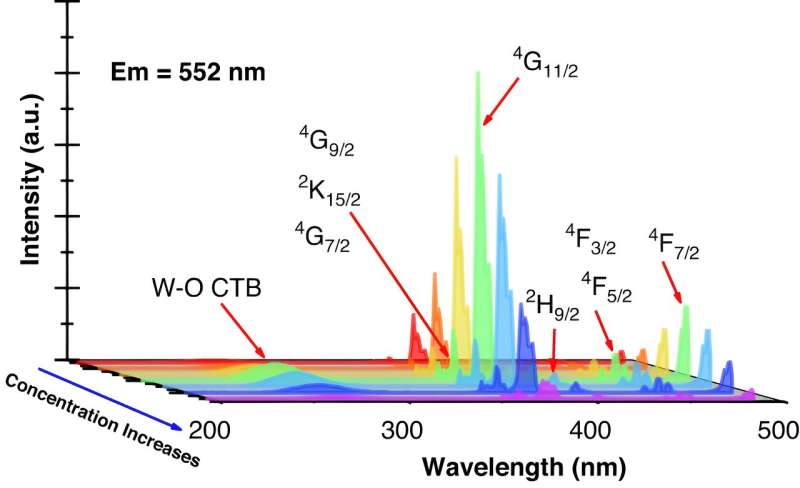This article has been reviewed according to Science X's editorial process and policies. Editors have highlighted the following attributes while ensuring the content's credibility:
fact-checked
trusted source
proofread
Quantum cutting, upconversion, and temperature sensing help with thermal management in silicon-based solar cells

Introducing light conversion materials into silicon-based photovoltaic devices is an effective way to improve their photoelectric conversion efficiency. Light conversion materials include quantum cutting materials and upconversion materials.
The purpose of introducing quantum cutting materials is to divide a short-wavelength photon into two or more photons that can join the photoelectric conversion in silicon-based photovoltaic devices. Introducing upconversion materials is done to combine two or more infrared photons into one photon that can also be used for photoelectric conversion in silicon-based photovoltaic devices.
The introduction of light conversion materials can improve photoelectric conversion efficiency without changing the performance of silicon-based solar cells themselves. This method can greatly reduce the technical difficulty of improving the efficiency of silicon-based photovoltaic systems. In addition, silicon-based photovoltaic devices are exposed to sunlight, so their temperature must be managed. Managing this temperature necessitates measuring it in advance.
However, it is possible that if three materials that can individually achieve quantum cutting, upconversion, and temperature sensing are simultaneously introduced into silicon-based solar cells, it will lead to difficulties in solar cell structure design and unnecessary increase in the product costs. Therefore, finding and developing high-performance materials that combine the above three functions is a challenge.
In a new paper published in Light: Science & Applications, researchers from the School of Science, Dalian Maritime University reports that they have achieved highly efficient photo split, nearly pure infrared upconversion emission, and suitable temperature sensing for thermal management in silicon-based solar cells by adjusting the doping concentrations of Er3+ and Yb3+ in NaY(WO4)2 phosphor.
The work reveals that this all-in-one material is an excellent candidate for application in silicon-based solar cells for improving their photoelectric conversion efficiency and enhancing their heat management.
An in-depth understanding of the quantum cutting mechanism is significant for designing and assessing the quantum cutting materials. However, in many cases, quantum cutting processes are complicated. In this work, the authors carefully decrypted the photo-splitting steps in Er3+/Yb3+ co-doped NaY(WO4)2 to assist the doping-concentration-dependent spectroscopy and fluorescence dynamics.
The team states, "Based on the optical spectroscopic analyses, the quantum cutting mechanism was discovered, and the photon splitting process includes two-step energy transfer processes, namely, 4S3/2+2F7/2 4I11/2 +2F5/2 and 4I11/2 + 2F7/2 4I15/2 + 2F5/2."
The quantum cutting efficiency can be confirmed experimentally and theoretically. In the ideal case, the measured quantum cutting efficiency is also defined as the internal quantum efficiency, but it is different from the traditional definition of internal quantum efficiency. The measuring technique for the quantum efficiencies is still not satisfactory since the measuring results are complicated by too many uncontrollable factors.
Therefore, the theoretical internal quantum cutting efficiency becomes significant. The authors claim, "The quantum cutting mechanism was discovered by the optical spectroscopic analyses, and the quantum cutting efficiencies were calculated in assistance of Judd-Ofelt theory, Föster-Dexter theory, energy gap law." The authors estimated the internal quantum cutting efficiencies for NaY(WO4)2: Er3+/Yb3+ by taking radiative transitions, non-radiative transitions, and energy transfers into account, and achieved an efficiency as high as 173%.
Another important point of this work is that the researchers achieved nearly pure near-infrared emission of Yb3+.
The team observes, "These upconversion mechanisms tell us that both Er3+ and Er3+/Yb3+ doped NaY(WO4)2 phosphors exhibit strong near-infrared emissions from 4I11/24I15/2 of Er3+ and 2F5/22F7/2 of Yb3+ that indicates the studied phosphors are good light conversion candidate[s] for silicon-based solar cell applications."
More information: Duan Gao et al, Near infrared emissions from both high efficient quantum cutting (173%) and nearly-pure-color upconversion in NaY(WO4)2:Er3+/Yb3+ with thermal management capability for silicon-based solar cells, Light: Science & Applications (2024). DOI: 10.1038/s41377-023-01365-2
Provided by Chinese Academy of Sciences




















